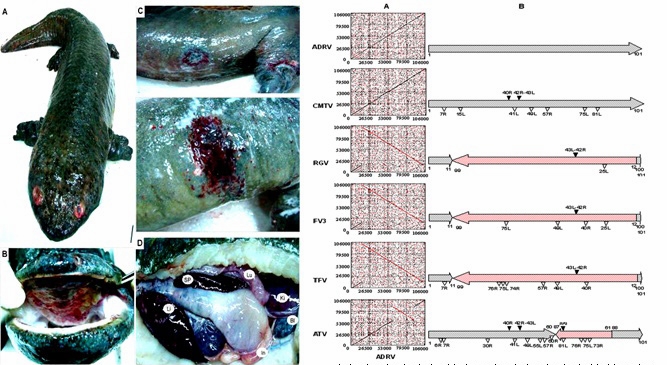
Newsroom
Revealed: Complete Genome and Genomic Architecture Changes of Andrias davidianus Ranavirus (ADRV)
L: Main symptoms of the diseased Chinese giant salamanders R: Dot plot comparisons and genome architecture changes of amphibian subgroup ranaviruses (Image:IHB)

The Chinese giant salamander Andrias davidianus, is a rarely endangered species and the largest amphibian in the world. It is endemic to China, and was enlisted as a class II protected species. Iridoviruses are important pathogens of the aquatic organisms including fish, amphibians and reptiles, and have been prevalent around the world. There is evidence to suggest that iridoviruses have contributed to the disappearance or decline of wild amphibian species including frog and salamander. Identification and genomic characterization of the iridovirus pathogens is a critical first step in developing strategies to control outbreaks of the disease.
Prof. Zhang Qi-Ya, Prof. Gui Jian-Fang (Institute of hydrobiology, Chinese Academy of Sciences) and Prof. Hong Yi-Jiang (Nanchang University) recently started a cooperation of studying viral pathogen in Chinese giant salamanders. Based on the isolation and identification of a novel ranavirus (Andrias davidianus ranavirus, ADRV) from diseased Chinese giant salamanders that exhibited systemic hemorrhage and swelling syndrome, they determined and molecularly characterized its complete genome, and analyzed the significant genome changes between the virus and other ranaviruses.
The complete nucleotide sequence of ADRV consists of 106,734 bp and contains 101 open reading frames (ORFs). Based on sequence homology to other characterized proteins, 26 ORFs were identified as iridovirus core genes, 24 ORFs as ranavirus-specific genes and 11 ORFs as amphibian subgroup-specific genes.
In addition, several variable major genes, such as duplicate US22 family-like genes, viral eukaryotic translation initiation factor 2 alpha gene and novel 75L gene with both motifs of nuclear localization signal (NLS) and nuclear export signal (NES), were predicted to contribute to pathogen virulence, host susceptibility and interspecies transmission.
This is the first report describing the complete sequence and molecular characterization of ranavirus isolate from Chinese giant salamander. These findings will greatly facilitate the understanding of the epidemiology of ADRV in Chinese giant salamanders and the evolutionary emergence of ranaviruses, and also provide useful information for developing strategies to prevent and control of ranavirus diseases in amphibians.
This work was supported by grants from the National Major Basic Research Program, National Natural Science Foundation of China, Program of the Chinese Academy of Sciences, and Key Projects in the National Science and Technology Pillar Program during the Twelfth Five-Year Plan Period.
It was mainly performed by Dr. Chen Zhong-Yuan, and Prof. Zhang Qi-Ya was the corresponding author. The results have been published online in Vetrinary Research entitled "Genome architecture changes and major gene variations of Andrias davidianus ranavirus (ADRV)" (http://www.veterinaryresearch.org/content/44/1/101).